Client Requests
Part 1 - Project Brief
Buddies: Make it easy and secure for scuba divers to locate the perfect partner to dive in the USA by designing a mobile app experience that speaks to this demographic. Think about the design process from the point of view of both the location for diving and the buddy seeker while designing the interface. How else can this product improve the scuba buddy experience after the perfect match has been made?
We want you to pinpoint challenging aspects of the UX process of “finding/keeping a decent buddy” and come up with potential solutions to those challenging aspects of the process.
Specs and features
Let’s focus the above problem on a mobile device with a resolution of 375x812 in either landscape or portrait modes. In addition to this, let’s use the following constraints:
● Focus your work around the process of capturing, measuring, and sharing insights, as well as any follow-up actions or activities you see benefitting the experience.
● Try to think in terms of a flow rather than isolated screens to help show the mechanics behind your idea(s)
What we’re looking for
We aren’t looking for a large volume of screens; instead, try to focus your work on just the basics to help support your idea. We encourage sharing your thought process - how did you get there? What did your assumptions, research, and ideation phase look like?
Note: This phase should be completed only in wireframe-level fidelity.
Part 2 - Hi-Fidelity pitch
In this second portion of work, we'd like to see a High-fidelity pitch that showcases the product's potential look and feel. Things to consider here would be aesthetic choices, Key UI elements like color and typography, and any additional unique visual elements.
● No need to re-create every screen in high fidelity, just choose 1-3 key screens to help showcase your approach. Make sure to consider rationale, narrative, and any divergent thinking for this HiFi work.
● We aren’t looking for a specific aesthetic design-wise, instead, consider an appropriate tone and voice for this demographic.
● Bonus points for considering how motion could bring the work to life, or add areas of delight for the user.
Presentation Template
1. PROCESS
(Include as much as you like. For example, sketches, assumptions, research, or wireframes)
2. PROTOTYPE
3. FINAL DELIVERABLE
4. FINAL THOUGHTS
Additional details:
1. We don’t expect you to use too much of your time, we estimate 1-2 hours should be enough. We are looking to understand your process behind and peeking a little bit of your skill set.
2. This brief is not associated with our business, so it is not a product we will ever use. It is only for evaluation purposes for the position you are applying to.
3. You don’t need to be an expert in the topic in order to design, principles are universal and we won’t be evaluating the accuracy of your data. Instead, we will focus and discuss the design decisions made.
Solution:
Mobile App for Connecting Scuba Divers
PROCESS
1. Defining challenges
• Limited knowledge of diving: I need to rely heavily on user research to understand diver needs and behaviors.
• Limited exposure to highly specialized “match-making”-type apps, so researching relevant app patterns and focusing on core functionalities is necessary.
• Limited time: Prioritization is key. Focus on core user needs and functionalities that can be delivered within the timeframe.
• Small screen size (375x812): The design is for simplicity, prioritizing essential information with a minimum touchpoint size of 44x44.
2. Gathering information (integrating planning, strategy, and discovery phases)
Sources
• Phone interviews:
Questions about the most significant challenges when finding diving buddies, etc.
– Diver 1 (30 min): Discuss general diving experiences, app usage (if any), and frustrations with finding diving buddies.
– Diver 2, instructor in a diving school (20 min): Gather additional insights and confirm/complement information from Diver 1.
• AI Assistance:
Leverage large language models like ChatGPT and Gemini to:
– Describe 3 scuba diving personas.
– Describe 3 scuba diving personas looking for a diving buddy.
• Competitive Research:
Rationale:
In this project, I opted to conduct competitive research after developing user personas and the user journey. This approach deviates from the typical design process, where competitive research often happens upfront.
My reasoning was twofold:
– Focus on User Needs First: Prioritizing user research allowed me to deeply understand diver needs and pain points before exploring existing solutions. This ensured the app design remained user-centered and addressed core user challenges.
– Quick Approach vs. Existing Solutions: By conducting competitive research later, I could directly compare my persona-driven functionalities to existing apps. This approach aimed to identify potential areas of differentiation and ensure my "quick approach" offered unique value to divers.
Competitors considered:
– Diveboard: Android / iOS
– Dive Log: iOS
– Buddy: Dive Log & Community: Android / iOS
3. Developing personas (examples)
Michael, The Solo Traveler:
• Age: 30
• Occupation: Travel Blogger
• Scuba experience: Advanced Open Water certified with frequent solo travel.
• Needs:
– Secure platform with verified diver profiles.
– Advanced search filters based on location, experience level, and preferred dive types.
– Precise communication tools for contacting potential dive buddies.
– Ability to review past dive experiences from other users.
UX Flow:
1. Michael sets their location and desired dive dates.
2. The platform suggests divers in the area with matching certifications and interests.
3. Michael can easily view diver profiles, including experience summaries, preferred dive styles, and past reviews.
4. Secure chat functionality allows Michael to contact potential buddies and discuss dive plans.
Maya, The Local Enthusiast:
• Age: 25
• Occupation: Graphic Designer
• Scuba experience: Recently certified with a desire to explore local dive sites.
• Needs:
– Local dive community forum or group feature.
– Calendar showing upcoming dives organized by other divers.
– Ability to express interest in joining planned dives.
UX Flow:
1. Maya logs into a local dive community section of the app.
2. The platform displays a calendar with upcoming dives planned by other users.
3. Maya can browse details like dive location, depth, and type.
4. Maya can express interest in joining a specific dive with a single click, allowing the organizer to contact her.
Daniel, The Socially Cautious Diver:
• Age: 42
• Scuba experience: Advanced certified with a preference for small, experienced dive groups.
• Needs:
– Detailed diver profile creation beyond basic certifications.
– Matching algorithm that considers personality preferences and diving style.
– Ability to participate in dive buddy "chats" before committing to a dive.
UX Flow:
1. Daniel creates a comprehensive profile including diving philosophy, preferred buddy communication style, and comfort levels with different diving situations.
2. The platform uses this information to suggest compatible dive buddies.
3. Daniel can join group chats with potential dive partners to assess their personalities and diving approach before finalizing a buddy.
4. Describing the elements of the user journey
Touchpoints:
• Website/App Homepage
• Registration and Profile Setup
• Searching for Diving Buddies
• Reviewing Profiles
• Messaging and Communication
• Planning the Dive
• Meeting Up and Diving Together
• Post-Dive Debriefing and Feedback
Customer Sentiments:
• Excitement and anticipation about finding a suitable diving buddy.
• Eagerness to explore new dive sites and experiences with a compatible partner.
• Anxiousness about meeting someone new and ensuring compatibility and safety.
• Satisfaction and fulfillment after finding a diving buddy and having a positive dive experience together.
• Gratitude for the opportunity to connect with like-minded individuals and expand their diving network.
Pain Points:
• Concerns about safety and compatibility with potential diving buddies, especially for solo or novice divers.
• Limited availability of diving buddies who match the user's preferences and schedule.
• Frustration with the platform's search and matching algorithms if they don't provide relevant or accurate results.
• Uncertainty about initiating contact and starting a conversation with potential diving buddies.
• Challenges in coordinating logistics and planning the dive, mainly if conflicting schedules or preferences exist.
Actions:
• Registering and setting up a profile on the diving platform.
• Searching for potential diving buddies based on location, certification level, and dive interests.
• Reviewing profiles and evaluating compatibility with potential buddies.
• Initiating contact and engaging in conversations with potential diving buddies.
• Planning and coordinating dive logistics, including date, time, location, and equipment.
• Meeting with the diving buddy at the dive site and conducting pre-dive briefings.
• Diving together and ensuring mutual safety and enjoyment.
• Providing feedback and reviews after the dive experience.
Insights:
• Users value platforms that offer robust search and matching features to find compatible diving buddies efficiently.
• Clear communication channels and messaging systems facilitate connections and planning dives.
• Providing detailed user profiles and reviews helps build trust and confidence among users.
• Platforms should offer resources and guidance for initiating contact and planning dives, especially for novice divers.
• Feedback and reviews from users contribute to continuous improvement in platform functionality and user experience.
5. Describing the user journey step-by-step
1. Discovery Phase:
• Awareness: The user becomes aware of their need for a diving buddy, whether a solo diver looking for companionship or a novice diver seeking guidance and support.
• Research: They begin researching online platforms or communities specifically designed for divers to find buddies. This could include social media groups, dedicated diving websites, or specialized diving apps.
2. Onboarding Phase:
• Registration: The user creates an account on the chosen platform, providing necessary details such as name, email, location, and diving experience level.
• Profile Setup: They complete their profile by adding information about their diving certifications, experience, preferences, and other relevant details.
• Preferences: The user sets their preferences for finding a diving buddy, including location, availability, certification level, and dive interests.
3. Exploration Phase:
• Search: Using the platform's search or matching features, the user searches for potential diving buddies based on their preferences. They may filter results by various criteria, such as location, certification level, or dive interests.
• Profile Review: The user reviews the profiles of potential buddies, paying attention to their certifications, dive experience, reviews from other users, and any shared interests or preferences.
• Initiating Contact: If they find a potential match, the user initiates contact through the platform's messaging system to introduce themselves and discuss their compatibility and diving goals.
4. Connection Phase:
• Communication: The user and their potential diving buddy engage in conversations to get to know each other better, discussing their diving experience, availability, preferred dive sites, and other relevant details.
• Planning: Once they feel comfortable with each other, the user and their diving buddy start planning their dive together. They discuss logistics such as date, time, dive location, equipment, and special considerations.
5. Confirmation Phase:
• Finalizing Plans: The user and their diving buddy finalize the details of their dive plan, ensuring everything is agreed upon and in place for a successful dive.
• Confirmation: They confirm their dive arrangements through the platform's messaging system or by exchanging contact information for further communication.
6. Execution Phase:
• Meeting Up: On the day of the dive, the user and their diving buddy meet up at the agreed location, whether it's a dive center, marina, or directly at the dive site.
• Pre-Dive Briefing: They conduct a pre-dive briefing, discussing safety procedures, dive objectives, signals, and other relevant information.
• Diving Together: The user and their diving buddy descend into the water together, enjoying the underwater experience while monitoring each other's safety and well-being.
7. Post-Dive Phase:
• Debriefing: After the dive, they debrief and share their experiences, discussing highlights, observations, and lessons learned.
• Feedback: The user provides feedback on their diving buddy's performance and communication, helping to improve the platform's matching algorithms and overall user experience.
• Connection Maintenance: If the user had a positive experience, they and their diving buddy may exchange contact information to stay in touch for future dives or social activities.
6. User journey mapping
Due to time constraints, I opted to skip creating a User Journey Map (or storyboard, flow diagram, or user stories). While these tools are invaluable for understanding user interactions and guiding design decisions, prioritizing other aspects of the project was necessary within the given timeframe.
7. Ideation / Idea refinement
Challenge and Solution:
Traditional friend-finding apps haven't translated well to scuba diving. In diving, your buddy is crucial for safety – their skills and experience can literally save your life. Relying solely on basic profile information creates an unnecessary risk.
To address this, our application focuses on in-depth diver profiles. Users will answer questions specifically about their experience and skillset, creating a more comprehensive picture for potential dive buddies. While this requires a more involved profile setup, it fosters a richer user experience by ensuring informed connections.
A "graph profile" system (where connections and experiences are visually represented) could be valuable, but it falls outside this project's scope due to time constraints. This feature could be implemented in future development.
A "graph profile" system (where connections and experiences are visually represented) could be valuable, but it falls outside this project's scope due to time constraints. This feature could be implemented in future development.
Advanced Matching:
We'll implement an advanced filtering system for buddy searches, allowing divers to pinpoint specific experience levels and desired specialties.
Future Innovation:
As a potential technical advancement, we can integrate AI to analyze user profiles and automatically recommend the most compatible dive buddies for each query.
Visualization and Interaction:
Unlike traditional UI with complex layouts, our app prioritizes readability and ease of use in challenging environments. We achieve this through:
• Large, Clear Interface: Simple layouts with large text and buttons ensure information is easily readable even on a boat in bright sun or less-than-ideal weather conditions, where bouncing waves and spray can make focusing on screens tricky.
• Intuitive Navigation: Navigation relies on familiar finger gestures, minimizing the need for small buttons or precise interactions.
• Minimal Graphics: Essential supporting graphics enhance clarity without cluttering the interface.
This approach ensures divers can interact with the app quickly and confidently, regardless of the conditions.
Also, we can leverage animation beyond icons. Let's explore using animated hints for navigation and effects to enhance the profile creation and filtering processes. (Details are provided below.)
PROTOTYPE
Site mapping
Due to time constraints, I've outlined only the key functionalities through a module schema.
1. Welcome & Login (Landing Module)
2. My Profile (Profile Module)
3. Dive Log (Diving Log Module) - Consider integrating this with My Profile for automatic updates.
4. Search Setup (Filter Module)
5. Smart Match (Search Module) - Emphasizes the AI aspect.
6. Chat & Connect (Communication Module)
7. Diving Memories (Post-diving experience and impressions module) - Combines dive log and post-dive features.
Screen prototyping: ‘My Profile’ and ‘Search Setup’ modules

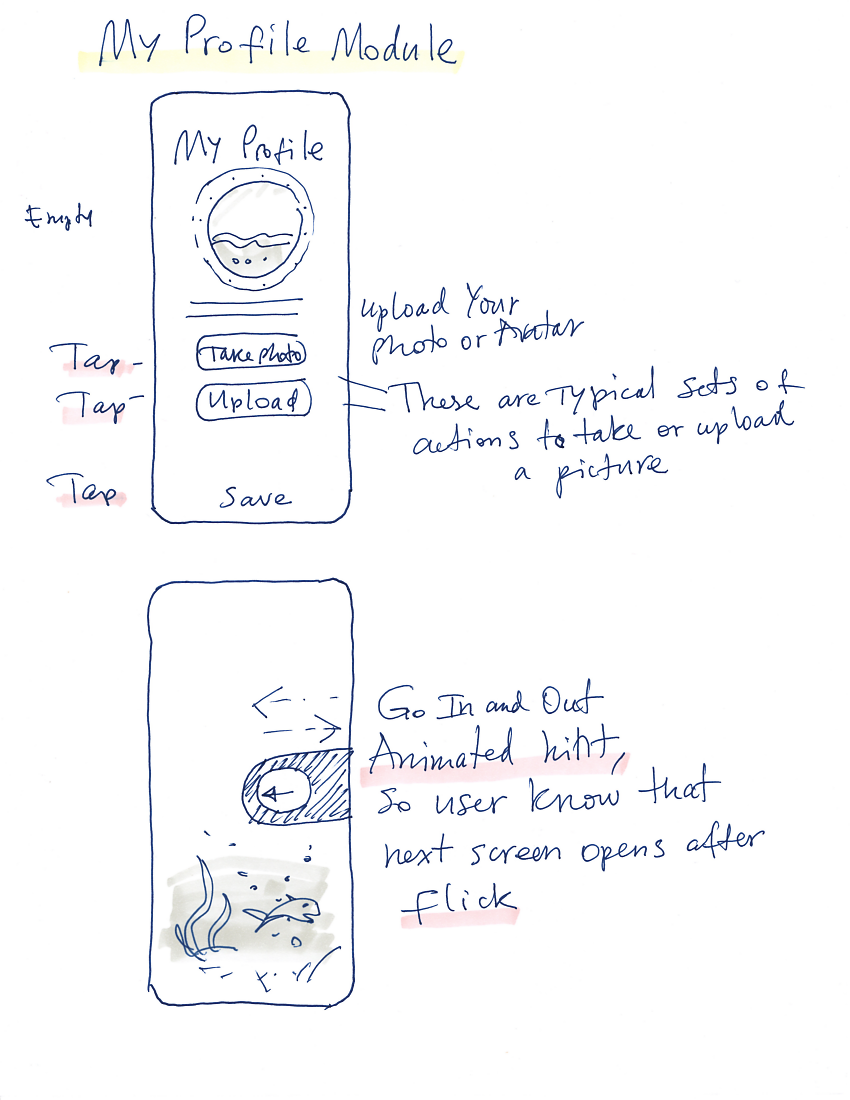
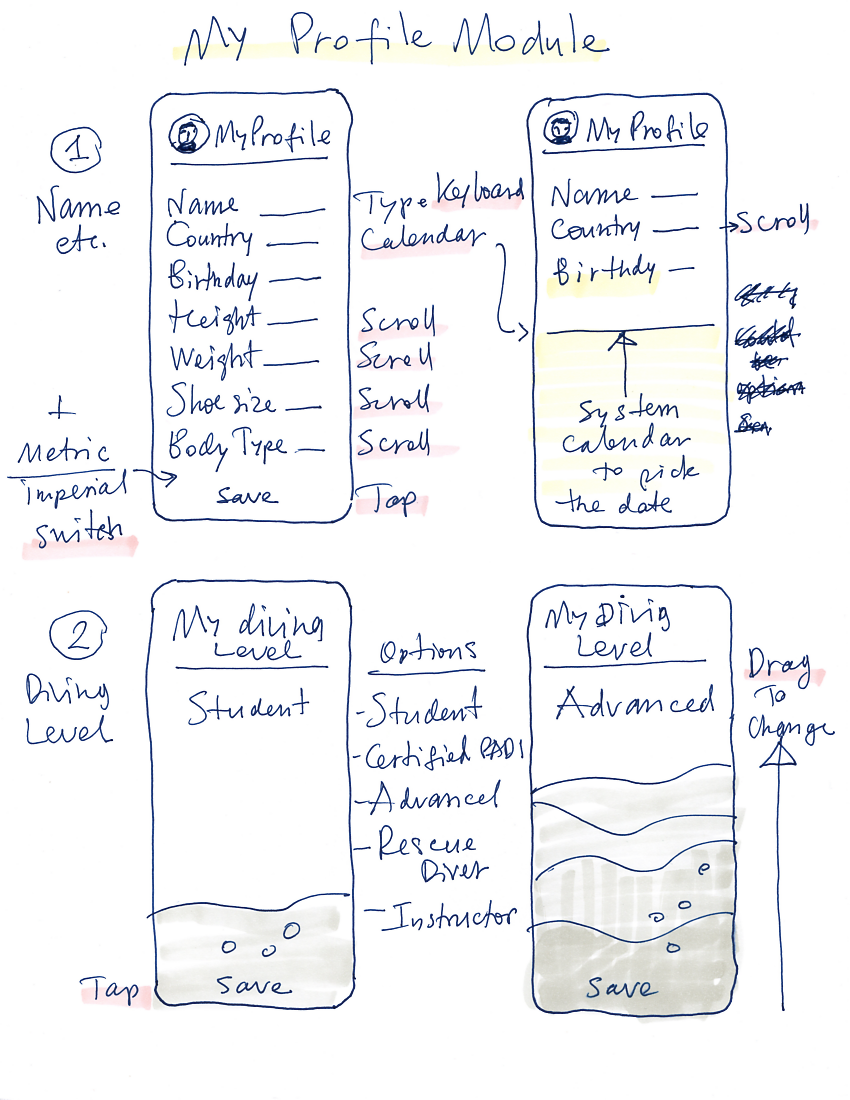

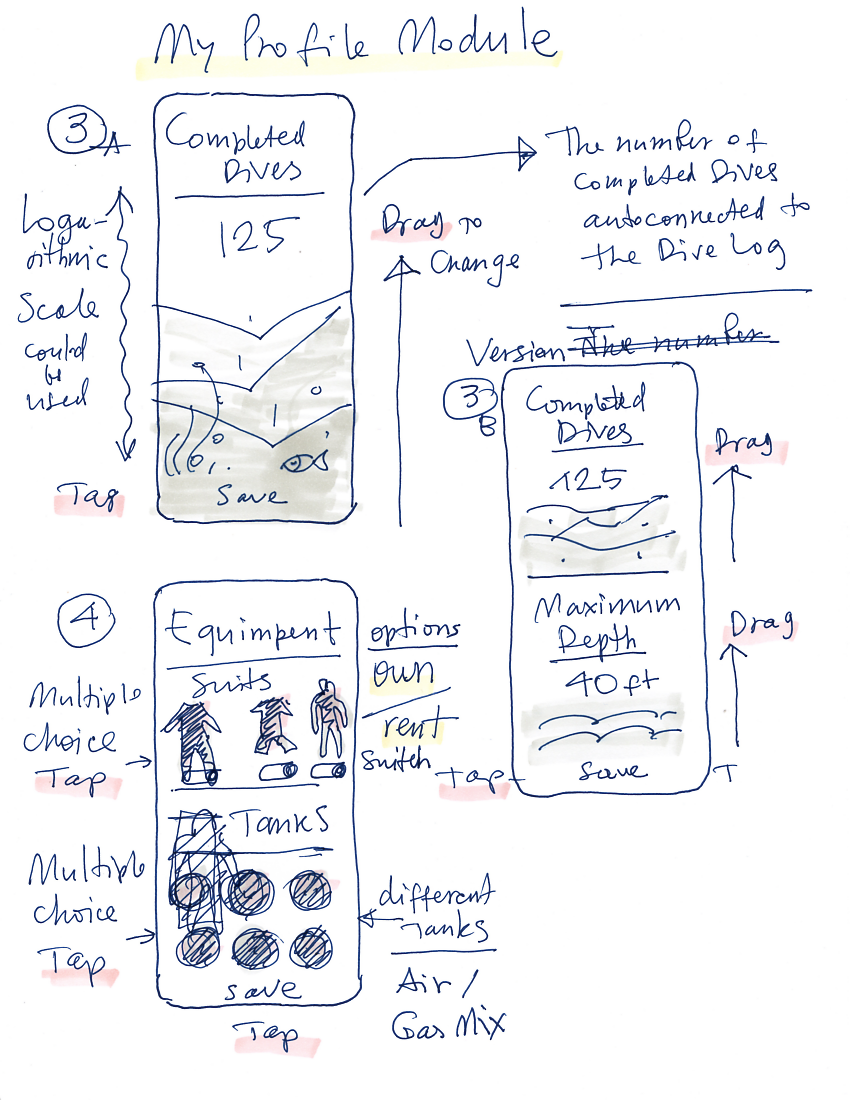
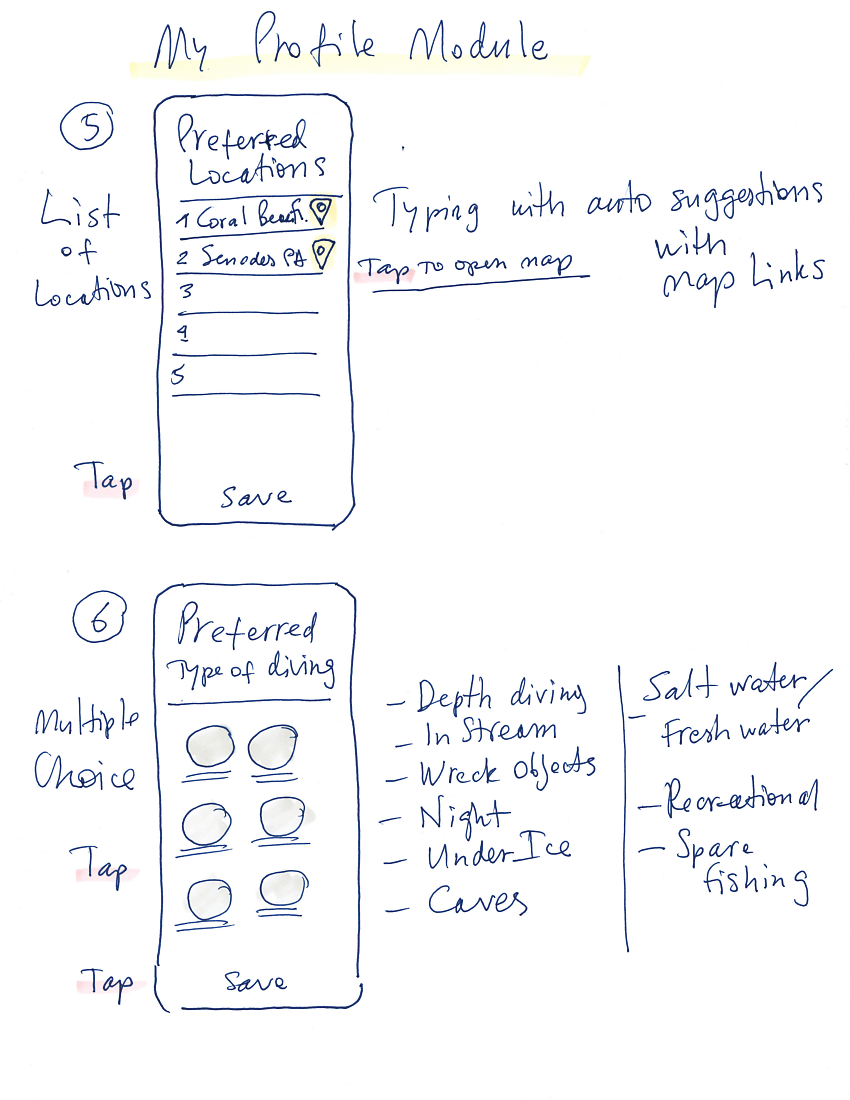

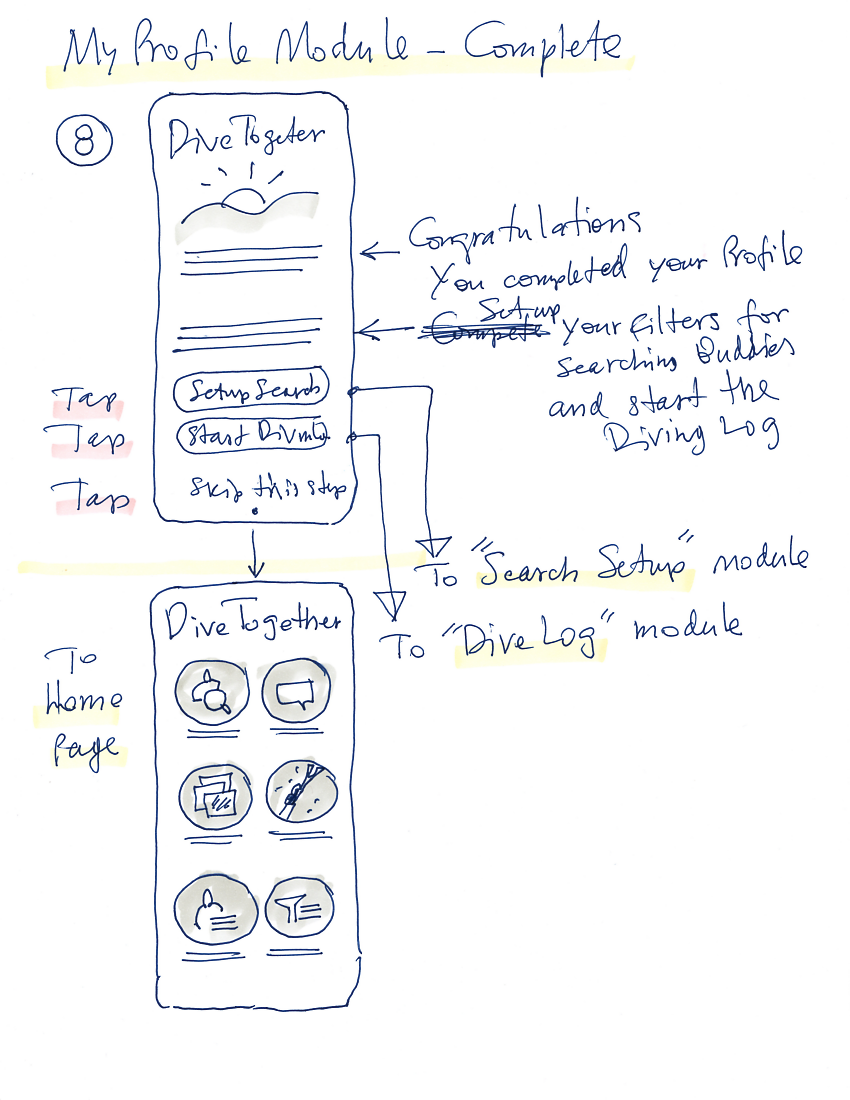
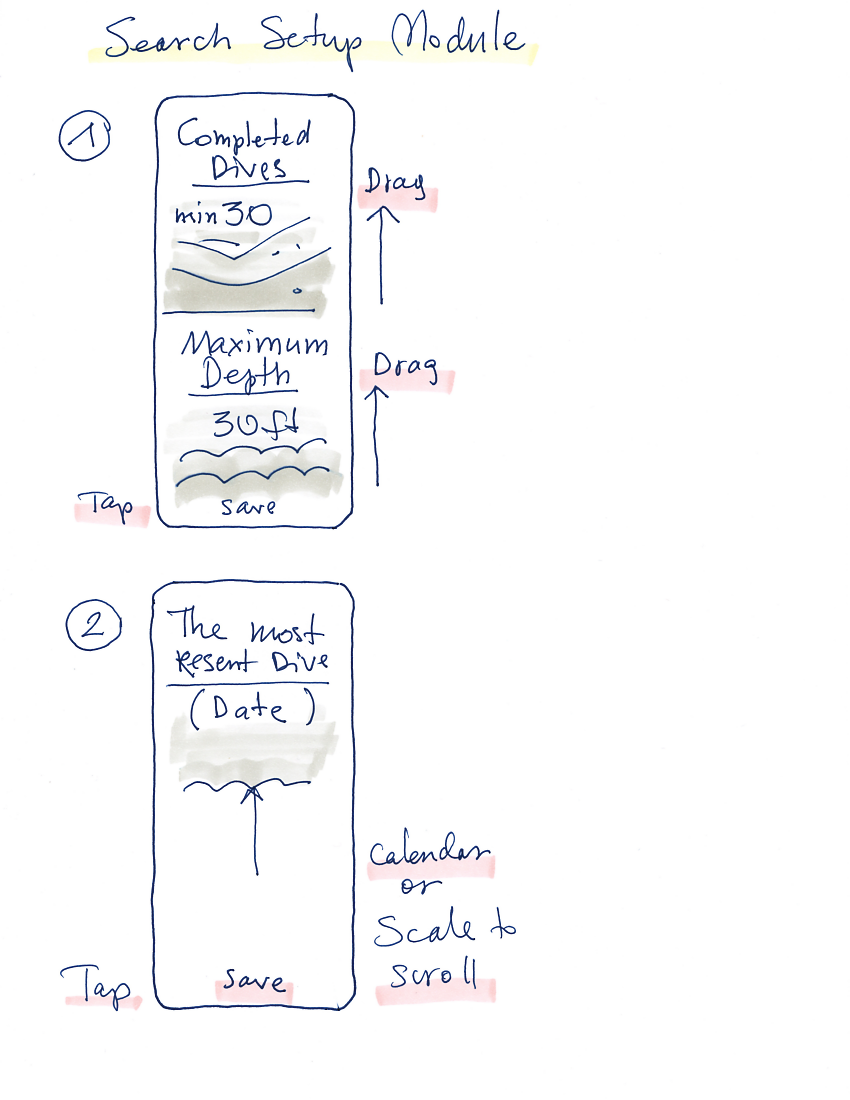
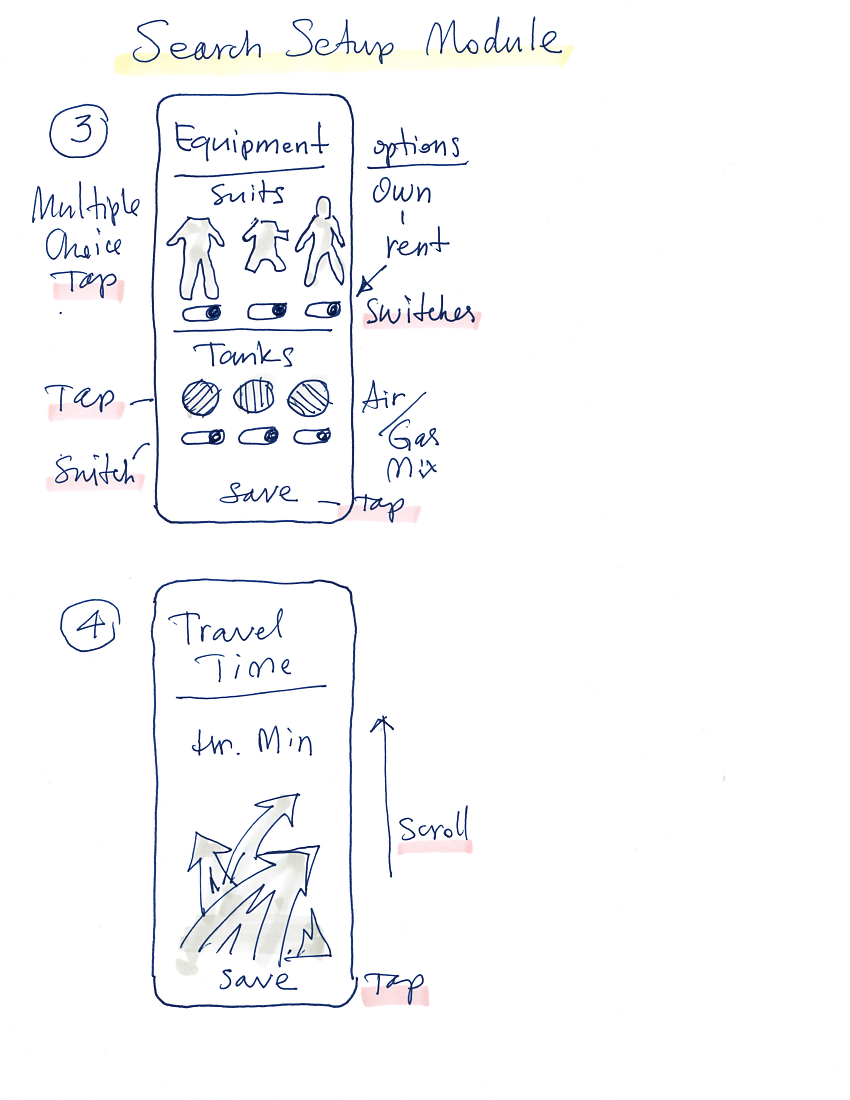


Usability feedback: Gathering insights
1. Diver 1
2. A person who engages in outdoor activities but has yet to dive
FINAL DELIVERABLE
Quick thoughts on aesthetic choices
• Oceanic Theme
• Minimalistic Interface
• Photographic Backgrounds (where appropriate)
• Day/Night Mode Switch
FINAL THOUGHTS
This project provided an excellent opportunity to explore design solutions for a specific user group. While the 2-hour timeline allowed me to focus only on the core features, I wanted to delve deeper into the app's social aspects. Overall, I'm confident that further developing this design solution could provide a solid foundation for scuba divers to find friends conveniently and safely.
I am particularly interested in collecting and sharing dive information. The wireframes demonstrate a streamlined process that allows users to connect and share valuable information. Although I chose a simple color scheme in a high-fidelity layout, I could explore a more vibrant, ocean-inspired aesthetic that resonates even more with the dive community.